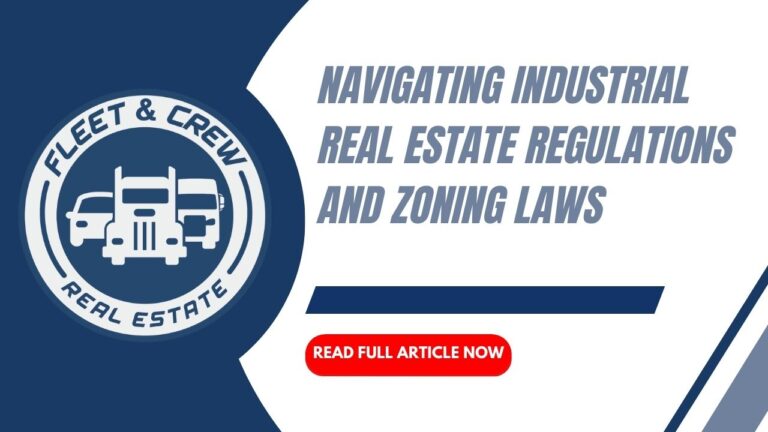The industrial real estate sector has experienced significant growth and transformation in recent years. As the global economy evolves and industries adapt to changing market dynamics, various trends are shaping the industrial real estate market. In this blog post, we will explore some of the key trends influencing the industrial real estate sector, from the rise of e-commerce to the impact of sustainability initiatives. Understanding these trends is crucial for investors, developers, and occupiers looking to navigate the ever-changing landscape of industrial real estate.
- E-commerce Boom
The rise of e-commerce has had a profound impact on the industrial real estate market. With consumers increasingly turning to online shopping, businesses require vast distribution centers and warehouses strategically located near urban centers to ensure fast and efficient order fulfillment. As a result, there has been a surge in demand for industrial properties suitable for e-commerce logistics operations. These properties often feature high ceilings, ample loading docks, and advanced technological systems to support rapid order processing and shipping.
- Last-Mile Delivery Focus
The emphasis on last-mile delivery—the final leg of the delivery process from the distribution center to the customer’s doorstep—has become a crucial consideration in the industrial real estate market. As customer expectations for fast and reliable delivery grow, companies are seeking smaller industrial spaces in urban areas to enable quick access to densely populated regions. The need for well-located facilities that facilitate efficient last-mile delivery has driven the development of urban warehouses, micro-fulfillment centers, and urban logistics hubs.
- Supply Chain Resilience
The COVID-19 pandemic highlighted the importance of supply chain resilience, leading businesses to reevaluate their supply chain strategies. To mitigate future disruptions, companies are diversifying their supply chains, seeking shorter and more localized supply chains, and adopting “just-in-case” inventory strategies. This trend has increased the demand for industrial real estate in multiple regions, as businesses look to establish distribution centers closer to their target markets to ensure faster delivery and reduce dependence on a single source.
- Adaptive Reuse and Repurposing
In response to changing market dynamics, there has been a growing trend of adaptive reuse and repurposing of industrial properties. Obsolete or underutilized industrial spaces are being transformed into modern, flexible facilities to meet the evolving needs of businesses. For example, vacant factories are being converted into mixed-use developments, industrial lofts, or creative office spaces. This trend not only breathes new life into old industrial sites but also maximizes the use of existing infrastructure in prime locations.
- Technological Advancements
Technological advancements continue to shape the industrial real estate market. Automation, robotics, artificial intelligence, and the Internet of Things (IoT) are revolutionizing industrial operations, leading to increased demand for specialized properties. These properties need to accommodate advanced systems, including automated storage and retrieval systems, robotic assembly lines, and smart sensors. Developers and investors are actively incorporating these technologies into industrial properties to attract tenants who seek modern and efficient facilities.
- Sustainability and ESG Initiatives
Sustainability and environmental, social, and governance (ESG) initiatives are gaining traction in the industrial real estate market. Companies are increasingly focused on reducing their carbon footprint and adopting eco-friendly practices. This shift has led to the emergence of sustainable industrial properties designed with energy-efficient systems, solar panels, rainwater harvesting, and other green features. Investors and tenants are placing greater emphasis on sustainability, leading to the development of green industrial buildings and the retrofitting of existing properties to meet sustainable standards.
- Shifts in Manufacturing and Industrial Processes
The manufacturing sector is experiencing significant changes, driven by advancements in technology, such as additive manufacturing (3D printing), robotics, and artificial intelligence. These advancements are reshaping industrial processes and redefining the requirements for industrial real estate. Manufacturers are seeking properties with flexible layouts, increased power capacity, and proximity to research and development centers. Industrial properties that can accommodate these changes and provide suitable infrastructure are in high demand.
- Expansion of Data Centers
The growth of cloud computing and the increasing demand for data storage have spurred the expansion of data centers. These facilities require specialized industrial properties with robust power infrastructure, cooling systems, and high-speed connectivity. As data centers continue to proliferate, the industrial real estate market has seen a rise in demand for properties that can support these critical digital infrastructure requirements.
The industrial real estate market is evolving rapidly, driven by the e-commerce boom, last-mile delivery focus, supply chain resilience, technological advancements, sustainability initiatives, manufacturing shifts, and the expansion of data centers. Understanding these trends is vital for stakeholders in the industrial real estate sector to adapt their strategies and seize opportunities in this dynamic market. Whether it’s developing modern and sustainable properties, repurposing existing spaces, or incorporating advanced technologies, staying attuned to these trends will help investors, developers, and occupiers thrive in the ever-changing industrial real estate landscape.




